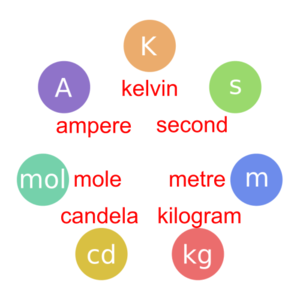S.I. Units
From DT Online
The modern metric system is the International System of Units (French: Système International d'Unités, SI). The system was published in 1960 and was based on the metre-kilogram-second system of units (MKS). There are now seven internationally agreed units plus units derived from them to cover all aspects of technology together with a set of prefixes which serve as multipliers or fractions of them.
The preferred prefixes multiply or divide the unit names by 1000 (or 10-3) thus, 10mm is preferred to a centimetre, especially in construction and engineering.
Note: Units named after people use capital letters for the letter symbol - but not for the unit name itself.
Measurement of Length
| Metre | ||||
|---|---|---|---|---|
| Prefix Name | Symbol | 10n | Decimal | Description |
| kilometre | km | 103 | 1000 | A thousand metres |
| metre | m | 100 | 1 | A metre |
| centimetre | cm | 10-2 | 0.01 | A hundredth of a metre |
| millimetre | mm | 10-3 | 0.001 | A thousandth of a metre |
| micrometre | μm | 10-6 | 0.000001 | A millionth of a metre |
Units used in Mechanics
| Prefix Name | Symbol | 10n | Decimal | Description |
|---|---|---|---|---|
| gram | g | 10-3 | 1/1000 | Originally the weight of a cubic centimetre of pure water but now defined as one-thousandth of a kilogram |
| kilogram | kg | 100 | 1 | S.I. Base Unit of Mass - equal to the mass of the International Prototype of the Kilogram |
| tonne | t | 103 | 1000 | Known as Metric Ton in USA (i.e. equivalent to approximately 2,204.6lbs whereas Imperial Ton = 2240lbs) |
| megatonne | Mt | 109 | 1,000,000,000 | Used for the energy of nuclear explosions and other similar events. |
| Newton | N | 100 | 1 | S.I. Base Unit of Force named after Sir Isaac Newton - the amount needed to accelerate a 1kg mass at 1 metre per second each second (1N = 1kg X ms2) |
| Newton Metre | Nm | 100 | 1 | S.I. Base Unit of Torque or Moment - resulting from applying a force of one newton perpendicularly to a moment arm which is one metre long (1Nm). It is calculated as for a joule but is preferred for Torque to avoid confusion with Work and Energy. |
| Joule | J | 100 | 1 | S.I. Base Unit of Work or Energy named after James Prescott Joule - the amount needed to apply a newton over the distance of a metre (1J = 1Nm) |
| Pascal | Pa | 100 | 1 | S.I. Base Unit of Pressure or Stress named after Blaise Pascal - the pressure exerted by applying a newton over a square metre (1Pa = 1Nm2) |
Units used in Electronics
| Ohms (resistance) - named after Georg Simon Ohm | ||||
|---|---|---|---|---|
| Prefix Name | Symbol | 10n | Decimal | Description |
| mega-ohm | MΩ | 106 | 1000000 | A million ohms |
| kilo-ohm | kΩ (or K) | 103 | 1000 | A thousand ohms |
| ohm | Ω (or R) | 100 | 1 | An ohm |
| Note:
The unit or its prefix may be used to replace a decimal point - e.g. 2.2mega-ohm = 2M2; 2.2kilo-ohm = 2K2; and 2.2ohm = 2R2. | ||||
| Ampere (electric current)' - named after André-Marie Ampère | ||||
| Prefix Name | Symbol | 10n | Decimal | Description |
| ampere | A | 100 | 1 | Amp |
| milli-amp | mA | 10-3 | 0.001 | A thousandth |
| Farads (electric capacitance) - named after Michael Faraday | ||||
| Prefix Name | Symbol | 10n | Decimal | Description |
| farad | F | 100 | 1 | A Farad |
| micro-Farad | μF | 10-6 | 0.000001 | A millionth |
| nano-Farad | nF | 10-9 | 0.000000001 | A thousand millionth |
| pico-Farad | pF | 10-12 | 0.000000000001 | A trillionth |
